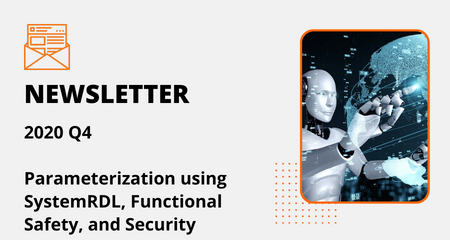
Newsletter 2020 Q4 | Agnisys

Happy New Year 2021 to you all !!!
With the new year, Agnisys tools have an amazing set of enhancements. In this year’s first newsletter we discuss some key features in our IDesignSpec (IDS) system that will be beneficial to you throughout the year. Parametrization using SystemRDL, Functional Safety, and Security are the topics we will go over.
Parameterization is one of the ways by which users can generalize a component for reuse. There are two types of parameters: Specification level parameters (Generation Time Parameters) and Output parameters (Elaboration Time Parameters).
Functional Safety features continue to be in high demand for register maps and so “SECDED” is discussed. SECDED stands for Single Error Correction, Double Error Detection. Sometimes, data in a register may get corrupted due to cosmic rays or some other factor, and this technique protects the system from catastrophic failures as a result of such corruption. A fault can eventually lead to a single failure or multiple failures in the system. The fault can occur due to hazardous environment conditions or due to cosmic rays that can knock out a storage bit in a system. The technique to provide tolerance against such single hardware component failure is triplication of the component, called Triple Modular Redundancy (TMR).
Security is becoming very important due to the connected world that we live in. IDS has been enhanced with the Advanced Encryption Standard (AES) for ensuring security of not just the register map but the entire system. AES is a popular and widely adopted symmetric encryption algorithm. It is used to encrypt and decrypt sensitive data and can be applied to both hardware and software.
As always, your comments and suggestions are welcome.
Advanced Encryption Standard – Advanced Encryption Standard (AES) is a popular and widely adopted symmetric encryption algorithm. It is used to encrypt and decrypt sensitive data and can be applied to both hardware and software. It is at least six times faster and uses a bigger key size (number of bits in the key) than earlier standards such as DES, triple DES, etc. This safeguards it against exhaustive key search attacks that are now more frequent due to increasing computing power. Read More
Hierarchical parameter overriding- Parameterization is one of the ways by which users can customize a component by specifying a generalized value of a component definition. According to the SystemRDL standard, “Parameter: A generalized value of a component definition that can be modified for each instance of the component.” Read More
SECDED in IDS- Functional safety is very vital in the designs today. There are various techniques that are used in the industry to provide this capability. The designs that are covered under it tend to automatically prevent failures and control them when they occur, depending upon the mechanism being used. It helps designers to ensure that the system can execute specific functions correctly, even under unfavorable conditions. Read More
TMR with error injection, detection and correction- Systems have been expanding widely in terms of both capabilities and resources. One of the major concerns, in the designs, is the occurrence of a fault in the system. A fault is a violation of some form in the normal (expected) working of the system. A fault can eventually lead to a single failure or multiple failures in the system. The fault can occur due to hazardous environmental conditions or due to cosmic rays that can knock out a storage bit in a system. In order to avoid this, there is a need to eliminate or control the fault. Read More